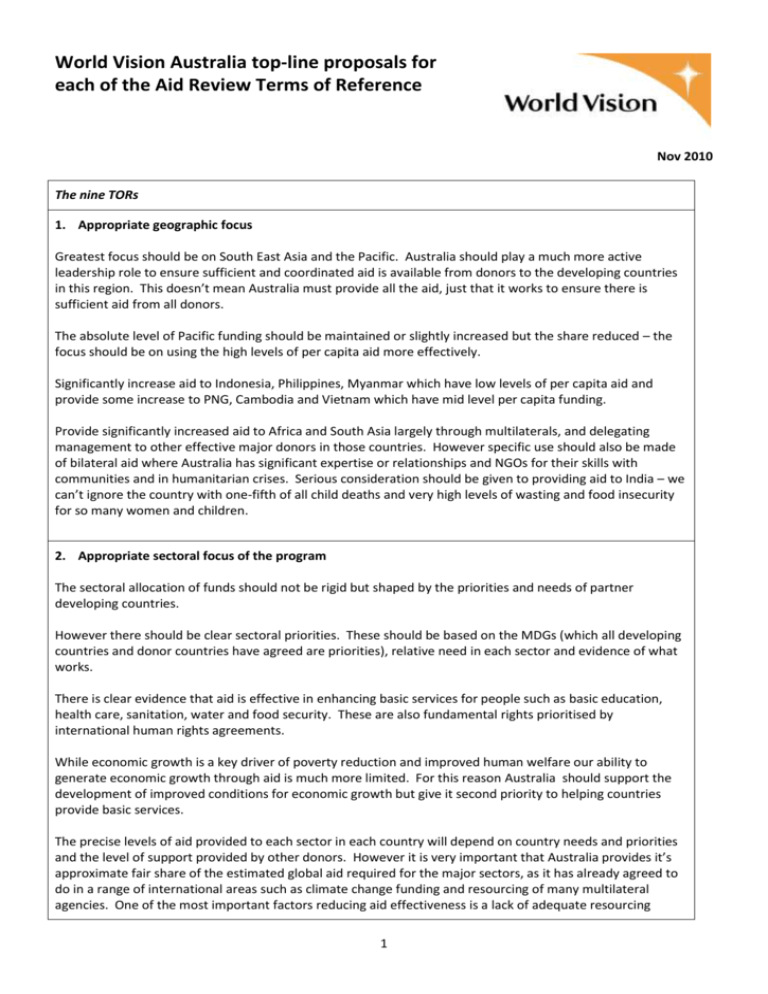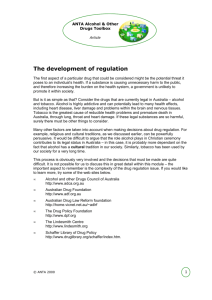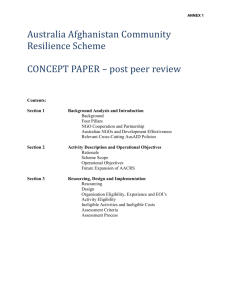World Vision Australia - Independent review of aid effectiveness
advertisement

World Vision Australia top-line proposals for each of the Aid Review Terms of Reference Nov 2010 The nine TORs 1. Appropriate geographic focus Greatest focus should be on South East Asia and the Pacific. Australia should play a much more active leadership role to ensure sufficient and coordinated aid is available from donors to the developing countries in this region. This doesn’t mean Australia must provide all the aid, just that it works to ensure there is sufficient aid from all donors. The absolute level of Pacific funding should be maintained or slightly increased but the share reduced – the focus should be on using the high levels of per capita aid more effectively. Significantly increase aid to Indonesia, Philippines, Myanmar which have low levels of per capita aid and provide some increase to PNG, Cambodia and Vietnam which have mid level per capita funding. Provide significantly increased aid to Africa and South Asia largely through multilaterals, and delegating management to other effective major donors in those countries. However specific use should also be made of bilateral aid where Australia has significant expertise or relationships and NGOs for their skills with communities and in humanitarian crises. Serious consideration should be given to providing aid to India – we can’t ignore the country with one-fifth of all child deaths and very high levels of wasting and food insecurity for so many women and children. 2. Appropriate sectoral focus of the program The sectoral allocation of funds should not be rigid but shaped by the priorities and needs of partner developing countries. However there should be clear sectoral priorities. These should be based on the MDGs (which all developing countries and donor countries have agreed are priorities), relative need in each sector and evidence of what works. There is clear evidence that aid is effective in enhancing basic services for people such as basic education, health care, sanitation, water and food security. These are also fundamental rights prioritised by international human rights agreements. While economic growth is a key driver of poverty reduction and improved human welfare our ability to generate economic growth through aid is much more limited. For this reason Australia should support the development of improved conditions for economic growth but give it second priority to helping countries provide basic services. The precise levels of aid provided to each sector in each country will depend on country needs and priorities and the level of support provided by other donors. However it is very important that Australia provides it’s approximate fair share of the estimated global aid required for the major sectors, as it has already agreed to do in a range of international areas such as climate change funding and resourcing of many multilateral agencies. One of the most important factors reducing aid effectiveness is a lack of adequate resourcing 1 caused by donor countries failing to provide their equitable contributions. By providing our fair share of aid for major sectors Australia will not only be carrying its fair load but also providing a powerful modelling effect for all nations (developed and developing) to meet their commitments. Specific sectoral priorities are: 1. lift health funding to the same priority as education in the budget – ie to approximately 20% of the budget - maintain the strong focus on health system strengthening and maternal and child health in the health program 2. reduce funding to Australian scholarships in favour of support for in-country tertiary education, including cross–country university collaborations along the lines of the Cambridge University Partnership Scheme. 3. ensure around 5% of aid budget allocations go to sanitation, water and hygiene 4. double the share of aid going to food security and rural development – to approximately 12-15% of the budget incorporating a strong focus on maternal and early childhood nutrition because of its lifelong effects 5. reduce the total proportion of aid going to governance and provide a near 50/50 balance of funding between top down and grass roots and human rights governance activities. Focus especially on the rights of women, children and the most marginalized communities. 6. ensure that gender equality is a top priority across all sectors and support this through research and gender balanced decision-making structures at all levels 7. incorporate disability considerations into all relevant sectoral activity and increase funding for disability inclusive development 8. incorporate climate change considerations into all relevant sectoral activity and ensure additional funding is available for this area. Like the UK, restrict ODA diversion to climate change to no more than 0.07% of GNI. 9. enhance support for early warning systems, disaster preparedness and long term neglected humanitarian crises and help build community resilience 10. increase funding for development research – this should include technical research (eg into plant breeding, medicines) and implementation research. Support should be given for Australian and developing country research institutions and collaborations between them. The aid review should take account of long term trends in developing the direction for the aid program. These include climate change, increased frequency of emergencies, water, land and energy shortages, population pressure, increased price volatility, patterns of conflict, new technologies, epidemics and urbanization. 3. Distribution to low and middle income countries Overall the country priority setting should be based on the poverty needs in each country, our capacity to improve things and our regional responsibilities. As large numbers of very poor people live in middle-income countries (three-quarters of those living on less than $1.25 a day, 60% of child deaths etc) we need to help address poverty in these countries. However the approach is likely to be different to low income countries. For example our health assistance to a country with very low income should have a strong resourcing component, while in a middle income country the focus is likely to be more on technical assistance to improve the distribution and effectiveness of domestic health expenditure. 2 4. Distribution channels Multilateral aid has the ability to reduce coordination costs for recipient countries, minimise administrative burden for Australia, provide sectoral expertise and to direct funding across the world to those places that require it most. For these reasons Australia should consider a minimum of 25% of its aid budget being channelled through core support for multilaterals. At the same time Australia should increase its active involvement in the management of multilateral organisations to help ensure that they maximise their effectiveness and are working in accord with Australia’s aid priorities. To further reduce transaction costs for developing countries and to enhance the impact of our aid a greater share of bilateral funding should be in the form of general budget support and SWAPs. To ensure the effectiveness of such funding, mutually agreed results- based conditions should be applied while maintaining flexibility for partner governments and communities to meet their needs. An increased share of the aid budget should also be channelled through Australian-based and developing country NGOs in those areas where NGOs offer a clear benefit and have the capacity to effectively utilise greater funding. Australia should reduce its reliance on consultants from developed countries in its aid program and instead seek to maximise developing country skill sharing and the transfer of resources to developing country economies. AusAID also needs to review its contracting arrangements to see if it can put downward pressure on its consultancy rates. While there is a need to reduce administrative burdens for developing countries and to increase the average size of projects there also needs to be space provided for pilot and experimental projects through all aid channels. 5. Performance of the aid program and lessons learned from Australia’s approach to aid effectiveness The overall focus of the Australian aid program and the openness and effectiveness of the program have improved considerably in recent years and it is generally well-regarded by other donor countries and by Australian NGOs. The underlying strategy of the Aid Review should be to enhance these positive aspects of the program. The main process improvements required are detailed in the next section. 6. Program’s approach to efficiency and effectiveness and whether the current systems, policies and procedures in place maximise effectiveness The aid program should retain its overall objective of poverty reduction and supporting the MDGs but with a stronger focus on reducing inequality. There is a risk that a review will seek to sum up the best direction in a few words or a catchphrase. This can only oversimplify the situation. 3 Despite significant improvements in recent years there are a number of areas that would benefit from further action. The key steps to improving effectiveness of Australian aid are : 1. increase transparency and make the program more open to the contesting of ideas – provide up-todate information about all funded activities and significantly expand the publication of project and sector evaluations, consider establishing an independent Aid Impact Commission 2. ensure lessons are effectively incorporated in future program planning 3. starting with this aid review, involve communities that are affected in aid planning, implementation and evaluation – close the accountability loop by supporting stakeholder groups in developing countries (including civil society groups, women’s organisations and parliaments) to hold both their own governments and donors (governments, INGOs, other actors) to account for the provision and delivery of aid 4. extend the Pacific Partnerships for Development model across the bilateral program and build mutually respectful and mutually accountable programs with all partner countries 5. provide long-term (at least five years) and predictable aid 6. ensure all relevant activities focus on the poorest and increase equity 7. coordinate better with other donors and take a lead in the Asia-Pacific to ensure the effective coordination of aid to each recipient country 8. use country systems more and improve country ownership including budget support and SWAPS where possible 9. significantly reduce use of technical assistance provided by Western consultants - use local rather than external advisors and institutions and ensure the vast majority of aid goes to improving resources on the ground 10. focus on prevention and early treatment – of diseases and illness, conflict, discrimination, disaster management, environmental management – take account of trends and act on them 11. cut staff turnover within AusAID 12. focus on development strategies that have been proven to work 13. make greater use of the skills and networks of NGOs to build civil society action, meet the needs of the poorest and respond to emergencies 14. act as a model to other countries by providing our fair share of support for international commitments 15. provide support for innovative pilot programs and learn from these 16. increasingly shape the program, its priorities and procedures in accord with human rights principles 17. provide adequate administrative resourcing for the expanded program and maximise the use of effective multilateral channels 18. ensure government policy coherence around development objectives (eg trade, intellectual property, research funding, migration, work visas, refugees, peace keeping) 19. maximise the effectiveness of aid by encouraging greater coordinated development efforts through world and regional forums such as the G20, UN and ASEAN. 4 7. Future organisational structure for the aid program and coordination with other donors Further increase aid coordination with other donors and take a lead to ensure effective coordination in the Asia-Pacific region. Examine the benefits of a separate aid department and minister for development cooperation. Consider establishing an independent Commission for Aid Impact. Enhance cross-government efforts through an enhanced DESC which considers not just aid policies, but the coherence of all government policies in the promotion of development. Play a leadership role in global and regional fora to promote coordinated development efforts. Consider establishing a permanent parliamentary committee on development to improve parliamentary involvement and increase the spotlight on development. Ensure gender-balanced representation in the structure and decision making positions of AusAID and the DESC. 8. Review and evaluation of the aid program Increase transparency and make the program more open to the contesting of ideas. Provide up-to-date information about all funded activities in an online project database. Increase mandate, authority and resources for the Office of Development Effectiveness to ensure that: The annual review of development effectiveness is published each year Major sector reviews are published at least each 2 years Country program strategy mid-term reviews are published All evaluations incorporate civil society input from affected communities to improve downward accountability but are also sensitive to minimising loads on communities and partner governments. Relevant ODE evaluations are incorporated in all aid planning. Consider establishing an independent Commission for Aid Impact. Carry out more research with other organisations to improve the quality of research and distribution of results eg Ie3 collaboration. Build capacity for research in developing countries. AusAID and ODE should regularly provide information about aid effectiveness and the benefits of Australian aid to MPs in an easily digestible form (for example, in an annual review of Australian aid programs). 5 9. The management of fraud and risk in the aid program Develop mutually accountable program agreements with each partner country. Incorporate results- based conditions for the expansion of support while ensuring that programs are still flexible and able to meet the specific needs of communities. Provide up-to-date information on all funded activities. Support civil society accountability in partner countries. Consider an independent Aid Impact Commission. In countries with poor levels of governance and or high levels of corruption make use of alternative distribution mechanisms, effective incentive structures and greater oversight by communities. Support high risk programs initially through pilot schemes. Work more with NGOs in Australia to raise public awareness about the benefits and complexities of aid. Focus on resources getting to the poor rather than just concerns about contractual responsibility. 6









